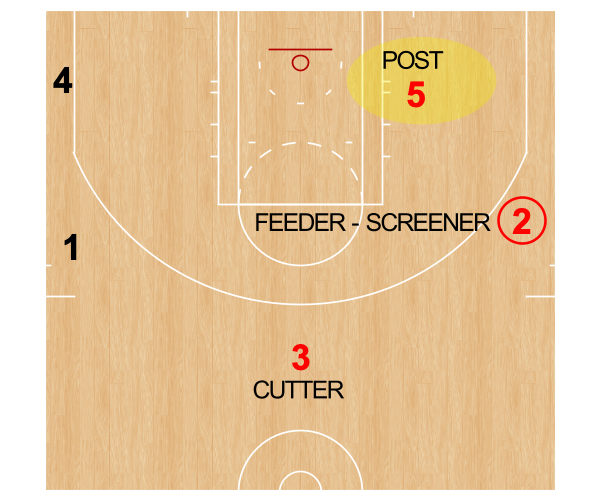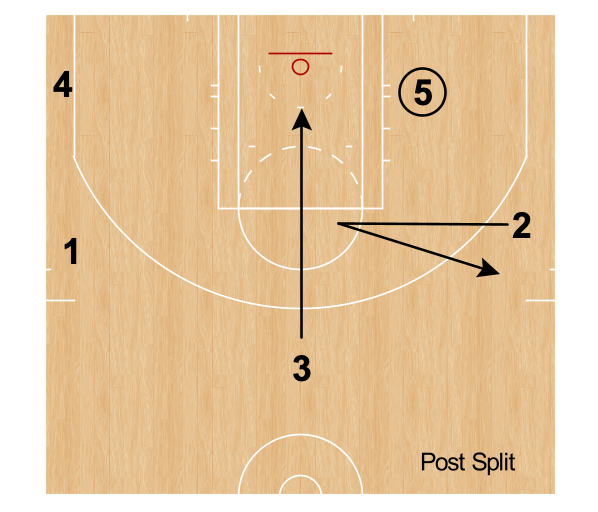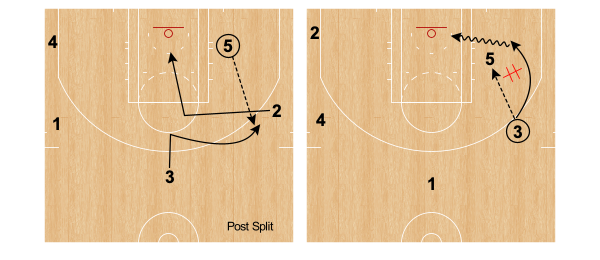The Post Split, a signature feature of the Princeton Offense, is one of the Miami Heat’s favorite concepts. What goes into it and how do we spot it?
More and more we are hearing that post play is dead. It is true that NBA teams use fewer post ups and attempt fewer shots from post ups than ever before. That trend will likely continue (with a few exceptions here and there).
However, getting the ball into the post area still has value. It is a way to penetrate the defense and can be a place to play-make from as the Miami Heat do by using the Post Split. The Post Split is a staple in the Low Post phase of Princeton Offense. The Heat, while not running Princeton, illustrate this particular concept.
https://youtu.be/VMfUYs0d8fI
The above video breaks down some Post Split possessions and a few of the reads involved. All of the scenarios diagrammed below are in this video!
Post Split Construction
LOW POST – Here’s the setup (Fig. 1). The players involved are in red. For example, when you see this alignment and the ball goes into Player 5, the Post Split is coming.

Player 2 is the feeder. The feeder initiates the action by passing into the post. The “post area” might be the better term (in yellow). At times Player 5 is not on the lane line. They are in the midpost or even deeper toward the corner. That’s ok! What matters is the ball gets to them.
Player 5 also uses the “T-Post” position. Instead of posting up with their back to the basket (think Patrick Ewing in the 1990s), they are perpendicular to their defender asking for the ball with their outside arm extended. This positioning gives them better court vision and they’ll need it to see what comes next – the screening action.

Split Action
When Player 5 gets the ball (Fig. 2) they become the passer. Player 2 is the screener. Player 3 is the cutter. They’ll be receiving the screen (in our Heat example, think Duncan Robinson or Tyler Herro).

The post area becomes the hub of the offense. Player 2 sets the screen for Player 3. Note in Fig. 3 how Player 3 sets up their man to be screened. This is vital. They must attack the space between them and their man.
Player 5 is looking for the cutter to come open on the wing. If the screen takes out X3, Player 3 may come open for a shot.
With the prevalence of switching defenses , Player 2 may slip the screen to the rim. If Player 2’s defender switches onto Player 3, there is a window for Player 2 to slip to rim.
A general rule in the split: we want one player cutting “out” and one player cutting “in” towards the rim (Fig. 3).
Other Split Options
When teams sense the split it coming, they tend to overplay the cutter. This sets them up for the reject (Fig. 4).

When teams overplay or anticipate the split screen, the cutter (Player 3) rejects the screen. Instead of cutting off the screen to wing, they dive to the rim.
Player 2 would then replace themselves. Again, we want one cut “in” and one cut “out.”
Lastly, there are times when the cutter comes open on the wing but they don’t immediately go into a shot or drive. What comes next? We’ve diagrammed two flows the Heat get to in this scenario.

In Fig. 5 above, the split action gets Player 3 a catch on the wing. Next, they receive a “step-up” ball screen from Player 5. Player 5 follows their pass immediately into this screen.

Another option when the ball gets to the wing in a Post Split (Fig. 6). In Frame 2 above, Player 3 throws it right back to Player 5 who is still T-Posted and goes right into a handoff. In a “Throw & Go” handoff, the passer tries to “outrun their pass” and take the ball back.
The Post Split allows Heat players like Bam Adebayo and P.J. Tucker be the hub of the offense. There is value in getting the ball “inside” the defense with an entry to the post area. Robinson and Herro are dangerous coming off the screens. There are tons of dilemmas for the defense.
Switch? Disrupt? Talk it out? They are not always perfectly executed, but the Heat have answers for all these in their Post Split attack.
